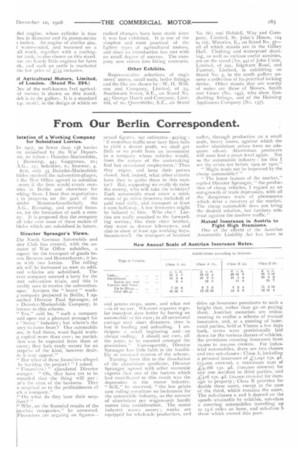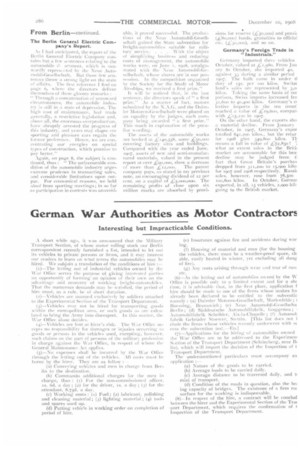From Our Berlin Correspondent.
Page 19

Page 20

If you've noticed an error in this article please click here to report it so we can fix it.
lotation of a Working Company for Subsidised Lorries.
In 1907, no fewer than ts8 lorries we subsidised by the War Departmt, as follow : Daimler-Marienfelde, ; Buessing, 44; Gaggenau, 20; A.G., 25; Scheibler, 6; Stoewer, 4.
first, only 35 Daimler-Marienfelde hicks received the subvention-plaque, t the War Office agreed to subsidise more if the firm would create crannies in Berlin and elsewhere for srleing them. I hear that negotiations e in progress, on the part of the tinder Motoren-Gesellschaft, the A.G.. Buessing, and several finanws, for the formation of such a cornny. It is proposed that the company all take over most of these makes of hides which are subsidised in future.
Director Spranger's Views.
The North German Automobile and otor Club has created, with the as;tame of War Office subsidies, a mpany for the transport of goods beeon Bremen and Bremerhaven ; it be ns with two lorries. The rolling xle will be increased as soon as addi mai vehicles are subsidised. The rent company entered a lorry for the :ent subvention trials, and this is erablv sure to receive the subventionNue. Apropos the " heavy " work company projected in Berlin, I ap°ached Director Paul Spranger, of e Daimler-Marienfelde Company, in ference to this scheme.
" Yes," said he, " such a company ruld open out a pleasant prospect for e ' heavy ' industry ; but where's the aney to come from? Our automobile ms, in bad times, want liquid workg capital more than ever ; no particilion can be expected from them at esent ; they lack ready money for an terprise of the kind, however desirle it. niay appear."
" But what of these financiers alleged he backing the project? " I asked. " Financiers ! " ejaculated Director )ranger. " Oh, they have yet to be N-suaded that the thing will pay : .at's the crux of the business. They e sceptical as to the profitableness of ch a company."
" On what do they base their seepism ? "
" Why, on the financial results of the otorbus companies," he answered. Financiers are arguing on figures— actual lig-um4, not estimates—saying : if motorbus traffic over busy lines fails to yield a decent profit, we shall get little or no profit from an investment in a company whose vehicles would, from the nature of the undertaking find but occasiOnal employment.' Thus they argue, and keep their purses closed. And, indeed, what other criteria have they to guide them in this matter? But, supposing we really do raise the money, who will take. the vehicles? Each automobile must cover a minimum of so miles (reserves included) of paid road daily, and transport at least
tons half-way. A few breweries might be induced to hire. ' Who else? Lorries are really unsuited to the forwarding service; like their elder brother, they want to devour kilometres, and also to show at least 250 working days. Season-wori the transport of beetroot
and potato crops, snow, and what not —is of no use. Whoever requires regular transport does better by having an automobile of his own; in all occasional cartage over short distances, time is lost in loading and unloading. I anticipate a small beginning and—an abrupt ending. I should not care, all the saute, to be counted amongst the pessimists.'' Consequently, Director Spraager leis little faith in the feasibility or eventual success of the scheme.
Turning from this to the dissolution of the aluminium syndicate, Director Spranger agreed with other economic experts that one of the factors which had contributed to this result was the depression in the motor industry. " he observed, " the low prices now ruling constitute no incitement for the automobile industry, as the amount of aluminium per wagon-unit hardly comes into consideration. The motor industry wars money ; works are equipped for wholesale production, and
suffer, through production on a small scale, heavy losses, against which the easier aluminium prices form no adequate off-set. Aluminium producers will soon find a mean level again. Not so the automobile industry : for this WA; the crisis not before 1909 or t9to."
" Might trade not be improved by the cheap automobile? " " The latter feature of the market," replied Director Spranger, " the production of cheap vehicles, I regard as an out-growth of trade depression, with all the dangerous train of phenomena which defer a recovery of the market. The cheap automobile does not bring the desired solution, but furthers mistrust against the modern traffic."
Mutual Insurance in Austria to Fight High Premiums. One of the effects of the Austrian Automobile Liability Act has been to
drive up insurance premiums to such a height that, rather than go on paying them. Austrian motorists are endeavouring to realise a scheme of mutual insurance, and, at a meeting of interested parties, held at Vienna a few days back, terms were provisionally laid down for the various classes of vehicles, the premiums covering insurance from to,000 to 200,000 crowns. For industrial automobiles, there arc two classes and two sub-classes Class A, including a personal insurance of 4'1,041 13$. 4d. (23,000 crowns), a maximum sum of 4'4,166 135. 4d. (too,000 crowns) for any one aocident to third parties, and .47416 135. 4d. (to,000 crowns) for damage to property; Class B provides for double these sums, except in the case of the third, which remains the same. The sub-classes a and b depend on the 'speeds attainable by vehicles, sub-class a coveting automobiles travelling up to 15.6 miles an hour, and sub-class b those which exceed this pace.
The Berlin General Electric Company's Report.
.1,, I had ant ideated, the report of the Berlin Genercd Electric Company contains but a few sentences relating to the automobile ailment, which is outwardly repre:e rted by the Neue. Automobil-G•eselisehaft. But those few sentenees throw n strong light on the state of affairs. The first reference I find on page 6, where the directors deliver themselves of these gloomy remarks : " Through a CI gicatertation of untoward circumstancys, the automobile industry Is,4i11 in a state of depression. The high cost of maintenance, had trade generally, a restrictive legislation and. above all, the enormous overproduction, have abruptly arrested the progress of this industry, and years may elapse ere sporting and pleasure cars regain the former preference. Hence, we are concentrating our energies on special pus of construction, which pro use to pay better."
Again, on page 8, the subject is continued, thus : " The unfavourable condition of the automobile industry urges extreme prudence in transacting sales, and considerable limitations upon output. For economical reasons, we held_ aloof from sporting meetings; in so far as partieipaticmn in contests was unavoid
able, it proved successful. The productions of the NemAutomobil-Gesellschaft gained the State subvention for freight-automobiles suitable for mili tary service. . . With the object of simplifying business and reducing costs of management, the automobile works were, on June 1, 1908, amalgamated with the Nine Automobil-Gesellschaft, whose shares are in our possession. In the competition organised by the Society for the Study of Motor Air-ships, WC received a first prize."
It will be noticed that, in the last sentence, the directors speak of " a first prize.– As a matter of fact, motors submitted lw the N..\ .G. and the Daimler Motoren-Gyselischaft were placed on an equality by the judges. each company being awarded '• a first prize." This much in explanation of the peculiar wording.
The assets of the automobile works are booked at i:140.558, some :50,000 covering factory sites and buildings. Compared with the year ended June, I 907, assets of new and emi-inanufacILI MI materials, valued in the present report at over ,4;9o,000, show a decrease of more than 412,000. The parent company pays, as stated in my previous note, an encouraging dividend of 12 per Cent, on a capital of -/e5,04m0,000'The remainingprofits of close upon six million marks are absorbed by provi
sions for reserve (1:5o,000) and pensic (,.:.80,10o) funds, gratuities to official de. („430,00o), a Ild so 011
Germany's Foreign Trade in "Industrials."
Germany imported three vehicles Octobd-, valued at 4.71,980. From Jan ary to October, she imported 40, against 33 during a similar period 19n7. The bulk carrte in under d duty of 15S. pi' moo kilos. Switz€ land's sales are represented by 3,0• kilos. Taking the same basis of cot prison, Swiss imports increased fro 3 Om E.1) 40,44,1(1 kilos. Germany's cc lective imports in the ten morn: reached it value of -‘719,600, compar, with fe.15,22o ht 1907.
On the other hand, the exports sho a material decline. From January October, in 1907, Germany's expor totalled 641,200 kilos., but the retur for myoS give 349,800 kilos. TI means n fall in value of 1:72,85o what an extent sales in the Brilti! market are accountable for this hea decline !nay be judged from ti fact that Great Britain's purehas dropped from 311,240 to 15,900 kilo: for 19o7 and ino8 respectively. Rossi: sales, however, rose from 78,500 mo,8on kilos. In October, Germai exported, in all, 15 vehicles, 2,900 kik going to the British market.
























